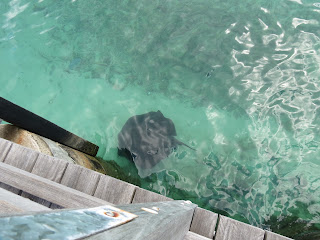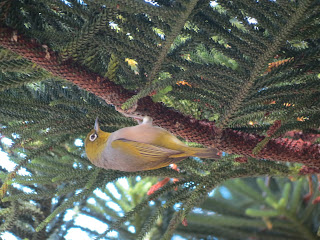Our first stop was an area of rocks below cliffs on the northern side of the island. Here there were many breeding red-tailed tropicbirds. Apparently the wandering tattler is sometimes seen on these rocks, however we could only find a few ruddy turnstones. The next stop was Roach Island, part of a small group of islands off the shore of Lord Howe. There were many masked boobies breeding on the island, with terns such as common noddies, black noddies and even grey ternlets flying around the island's cliffs.
This shot of a distant red-tailed tropicbird was taken later on from land
This young masked booby swam near our boat after falling into the water
The area around Norfolk and Lord Howe Islands is Australia's only site for grey ternlet
When we came to the seas around Mount Gower, we saw a large amount of Providence petrels feeding in the water. We also got a great view of the cliff face of Mount Gower.
The forested slopes of Mount Gower were beautiful in the afternoon light
Thousands of Providence petrels nest atop Mount Gower: a few can be seen here
This blurred and cropped shot of a Providence petrel does the bird no justice
Later on, when we were nearing Balls Pyramid, we stopped and put chum (a mixture of fish guts) in the water. This immediately attracted many flesh-footed shearwaters, as well as a few white-bellied storm petrels.
As we neared Balls Pyramid we got a beautiful view of the rock stack
The white-bellied storm petrel is another specialty of Lord Howe
A white-bellied storm petrel flies over a flesh-footed shearwater
This flesh-footed shearwater was quick to fly towards the chum
When we circled Balls Pyramid there were many nesting black noddies, common noddies and grey ternlets, as well as flesh-footed shearwaters circling the boat. Several noddies and ternlets flew near the boat for a few seconds to check us out, before darting away.
Balls Pyramid was even more spectacular from close range
On the way back we saw a group of swimming Bottlenose Dolphins, some flying fish and a distant wedge-tailed shearwater.
























































